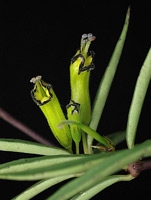
A
eschynanthus angustifolius (Blume) Steud. Plant
of the week, Smithsonian Institution,
phot. L. Brothers, http://persoon.si.edu/plofweek.index.cfm
Full name and orig. publication: Aeschynanthus Jack, Trans. Linn. Soc. 14: 42 (1823), nom. cons.
Etymology: Either from the Greek αισχυνη, aischyne = shame, αισχυνω, aischynō = to be ashamed, and ανθος, anthos = flower, alluding to the usually red corolla color, or (less probably) from αίσχυνειν, aischınein = deform, distort, and άνθος, anthos = flower, referring to the strange (?) form of the corolla.
Synonyms: Trichosporum D.Don (1822), nom. rejic., Rheitrophyllum Hassk. (1842), Euthamnus Schltr. (1923), Oxychlamys Schltr. (1923).
Infrafamilial position: Didymocarpoid Gesneriaceae - "Advanced Asiatic and Malesian genera" (Weber 2004).
Description: Epiphytic (rarely terrestrial) woody or lignescent plants. Stem terete, rarely (sub)quadrangular, branched or not, erect, spreading or pendulous; clinging to the substrate by roots emerging from the nodes. Leaves opposite (often arranged in a single plane by twisting of the internodes), rarely whorled; petiole short, lamina (linear to) lanceolate, ovate, or cordate (to suborbicular), margin entire, rarely obscurely denticulate; fleshy or leathery, with a water-storing hypodermis just below the upper epidermis; nerves usually obscure. Flowers in few-flowered axillary cymes or solitary, in leaf axils or emerging from scaly bracts and forming a pseudoterminal inflorescence; bracteoles ovate or scaly, rarely large and coloured, in most species deciduous. Sepals free and usually narrow, or partially or entirely connate and forming a cup-shaped or cylindrical often showy (coloured) calyx with small rounded lobes. Corolla usually bright red, more rarely orange, yellow, greenish yellow or greenish, tube usually long, arcuate, limb often with dark spots or stripes, bilabiate, lobes rounded. Stamens 4, didynamous, equalling the corolla or exserted, anthers coherent in pairs at the tips; staminode present or lacking. Nectary ring- or cup-shaped. Ovary stipitate, linear, style slender, stigma capitate or peltate; placentae lamelliform, deeply inflexed and recurved. Capsule linear, in some species up to 50 cm long, bivalvate, dehiscence loculicidal. Seeds very small, numerous, with a single short triangular or longer slender appendage at the apical end, and one triangular appendage or one to many slender appendages at the hilar end.
Chromosome numbers: 2n = 28, 30, 32, 48, 60, 64, 96.
Species number: Ca. 185.
Species names (incl. publication and synonyms): See Skog, L.E. & J.K. Boggan. 2005: World checklist of Gesneriaceae: http://persoon.si.edu/Gesneriaceae/Checklist.
Type species: Aeschynanthus volubilis Jack
Distribution: Ranging from S China (34 spp.), N and S India throughout Malesia to New Guinea and the Solomon Islands.
Ecology: Growing epiphytically on trees (rarely on rocks or bare soil), in lowland or montane rain forest.
Notes: All or at least the bulk of the species are ornithophilous. The old sectional subdivision, essentially based on the shape and number of seed appendages, is still of relevance. Additional sections were recently established by Wang (1984) for the accommodation of a S Chinese species with Digitalis-like (apparently melittophilous) flowers, and by Mendum et al. (2001) for a number of species previously placed in sect. Haplotrichium, but exhibiting a different seed structure (provisionally referred to as sect. X; they may be referable to sect. Xanthanthos, but more material of the latter is needed before a decision can be made). The sections now read:
(1) sect Haplotrichium Benth. sens. str. (seeds with a smooth filiform appendage at each end, no bubble-cells; sepals free or connate; India, SW China, Burma, Thailand)
(2) sect. Microtrichium C.B.Clarke (seeds with a single short triangular-conical (never filiform or hair-like) appendage at each end; Malesia, centre of diversity New Guinea)
(3) sect. Aeschynanthus (seeds with a smooth filiform appendage at each end, the one at the hilar end usually with bubble-like cells at the base; sepals connate in a cup-shape or cylinder; S Thailand to New Guinea, centre of diversity western Malesia),
(4) sect. Polytrichium Benth. (seeds with long papillose appendages, single at the apical end and in a coma at the hilar end; S China and Burma to New Guinea)
(5) sect. Diplotrichium Benth. (seeds with long papillose appendages, single at the apical and two at the hilar end; sepals nearly free to base; India, SW China, Burma, Thailand)
(6) sect. Xanthanthos W.T.Wang (corolla white or yellow, stamens not exserted, S China)
(7) sect. "X" (Mendum, provisional; seeds with a single long papillose appendage at each end; N & S India, mainland SE Asia, W Malesia, centre of diversity India, Indo-China and China).
Mendum et al. (2001) showed that there are two basic seed types in the genus (type A: testa cell orientation almost always spiral, papillae formed from single cells, appendages short, not papillose; subtypes equivalent to sects. Haplotrichium sens. str., Microtrichium and Aeschynanthus; type B: testa cell orientation straight, papillae formed from raised ends of two adjacent cells, appendages long, slender, always papillose, subtypes equivalent to sects. Polytrichium, Diplotrichium, Xanthanthos and X). The two seed types correspond with two large clades based on molecular data (Denduangboripant & Cronk 2000). The phytogeographical relations are discussed in Mendum et al. (2001) and in Denduangboripant et al. (2001). The wide distribution of sect. Polytrichium over mainland SE Asia and Malesia is probably due to the coma of appendages being effective in wind dispersal.
Arevision of Aeschynanthus in Thailand is in preparation by D. Middleton (E), an annotated checklist was published by Burtt (2001).
Selected references: Clarke, in A. & C. DC, Monogr. phan. 5/1: 18-52 (1883), rev.; Ridley, Fl. Malay Penins. 2: 496-501 (1923), reg. rev.; Burtt, Notes Roy. Bot. Gard. Edinburgh 28: 219-225 (1968), notes; Rosser & Burtt, Notes Roy. Bot. Gard. Edinburgh 29: 39-58 (1969), anat.; Burtt & Woods, Notes Roy. Bot. Gard. Edinburgh 33: 471-489 (1975), notes, rev. of sect. Polytrichium, new spp.; Wang, Bull. Bot. Lab. N.E. Forestry Inst. 4: 26-30 (1984), establishment of sect. Xanthanthos; Woods, Kew Mag. 8: 115-23 (1991), notes, new spp.; v. Royen, Alpine Fl. New Guinea 4 (1983), inclusion of Oxychlamys; Wang et al. in Wu & Raven (eds.), Fl. China 18: 375-385 (1998) (Chinese spp); Kiehn & Weber, Beitr. Biol Pflanzen 70 ("1997"): 445-470 (1998), karyol.; Denduangboripant & Cronk, Proc. Roy. Soc. London B. 267: 1407-1415 (2000); molec. syst.; Mendum et al., J. Linn. Soc. Bot. 135: 195-213 (2001), seed morph., phytogeogr.; Rashid et al., Edinburgh J. Bot. 58: 31-43 (2001), karyol.; Denduangboripant, Mendum & Cronk, Pl. Syst. Evol 228: 181-197 (2001), morph., molec. phylog., biogeogr.; Hilliard, in Grierson & Long, Fl. Bhutan 2(3): 1298-1303 (2001), reg. rev.; Burtt, Thai Forest Bull. (Botany) 29: 81-109 (2001), prov. rev.
Bibliography: See Skog, L.E. & J.K. Boggan. 2005. Bibliography of the Gesneriaceae. 2nd edition: http://persoon.si.edu/Gesneriaceae/Bibliography
Illustrations:

|
A eschynanthus angustifolius (Blume) Steud. Plant
of the week, Smithsonian Institution, |
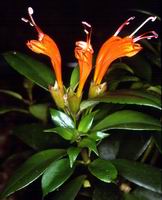
|
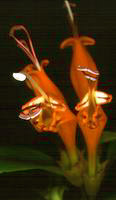
|
Aeschynanthus fulgens R.Br.
Cult. RBG Edinburgh, phot. A. Weber (2002) |
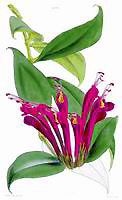
|
Aeschynanthus longiflorus
(Blume) A.DC.
Bot. Mag. t. 4328 (1847) |
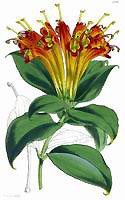
|
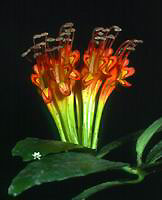
|
Aeschynanthus speciosus Hook.f.
Left: Bot. Mag. t. 4320 (1847) |
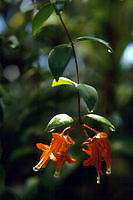
|
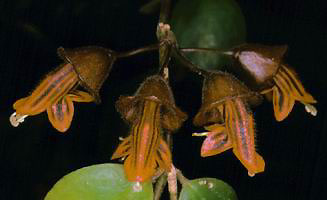
|
Aeschynanthus tricolor Hook.f.
Cult. Marie Selby BG, phot. A. Weber (1982) |
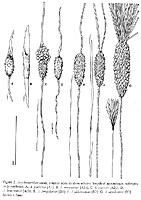
|
Seeds of various species of Aeschynanthus
Mendum et al., Bot. J. Linn. Soc. 135, Fig. 2 (2001) |
last modified: 2009-07-15